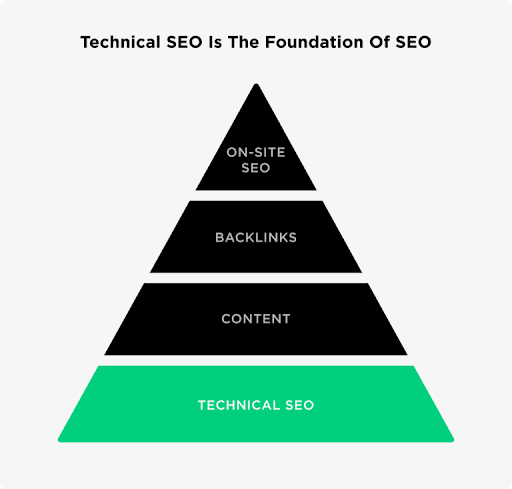Start Exploring Keyword Ideas
Use Serpstat to find the best keywords for your website
Best SaaS Digital Marketing Strategies

The demand for SaaS products is also almost infinite because more than 90% of businesses now use at least one SaaS product. So, every new business grows in the SaaS industry, regardless of sector. These numbers show the industry's competitive nature, making lead conversion a hot competition among SaaS digital marketers.
So, your innovative product will remain undiscovered if you're not going for the right crowd. SaaS digital marketing is all about convincing the right audience to become regular customers. Doing that involves using specific strategies to find leads and passing across messages that win them over.
This article covers the best marketing strategies to attract, convert, and retain leads.
2. Understand Your Competition
3. Build Your Buyer Personas
4. Define Your Business' Core Customer Charm
5. Understand Your Buyer Journey
6. Use SEO to Drive Organic Web Traffic
7. Content Marketing Strategies for SaaS
8. Design an Effective Link-Building Strategy
9. Video Marketing
10. Email Marketing
11. Social Media Marketing
12. Pay-Per-Click Advertising
13. Affiliate Marketing
Main Takeaway
1. Build Blocks for SaaS Marketing Strategies
Productive Marketing Team
There's no straightforward playbook on how to build a winning marketing team. Every hiring decision depends on your company's objectives and budget.
So, assess your current marketing team to confirm if it has what it takes to drive your digital marketing efforts.
Outsourcing vs In-House
An in-house team is more integrated and can interact better with your prospects. But the strain on your budget may be too steep.
Freelance Marketers
You can pay by the hour and monitor productivity and billable hours using a time tracking spreadsheet or a digital time tracker.
That said, you must provide the proper training to ensure they're correctly in tune with your brand's identity and culture.
Marketing Team Structure
You need a defined structure with clearly stated roles and responsibilities. For example, you may have to run different departments, such as content marketing, product marketing, search engine optimization, paid advertising, and demand generation departments.
In a small company, one professional can have a broader role in handling each department. But as your marketing needs start to scale, you may have to furnish each department with specialists.
Remember, each team member should have autonomy over their roles to boost creativity and innovation.
2. Understand Your Competition
By checking out your competitors, you're:
- identifying what makes your product stand out;
- discovering what they're doing right and wrong in terms of sales and marketing tactics;
- learning what their customers are missing;
- measuring your growth benchmark against their performance.
Let's say you already have a great product with unique offerings. So, your main marketing objective is brand exposure and lead generation.
You're essentially looking for answers to the following questions:
- Who is your closest competitor's target audience?
- How are your competitors reaching their audience?
- What is their messaging?
- What does the target audience like and dislike about your competitors?
- How do people react to your competitors?
- When do people use your competitors the most?
- What unique offerings do your competitors provide?
- Which keywords they are ranking for?
Thankfully, there are great tools for checking everything your competitors are up to and collecting the data you need. They include:
- Serpstat: Analyze your competitors' online footprint, including keyword trends and maps.
- Brand24: For brand monitoring.
- SparkToro: For checking out your competitors' audience.
- Social Status: For monitoring your competitors' social media presence and performance.
3. Build Your Buyer Personas
Since the idea behind SaaS digital marketing is focusing on the ideal audience, there's no point starting anything without knowing who you're targeting. The personas help you create copy, build landing pages, run ad campaigns, and influence your marketing endeavors.
According to Cintell's 2016 benchmark study on understanding B2B buyers, organizations that outperform revenue and lead target expectations are 3.8 times more likely to have and manage a buyer persona database.
To build your buyer personas, you can organize surveys, reach out to existing clients, and research your competition. You can also use testimonials, client interactions with your sales team, feedback, and data from your CRM.
- Pain points.
- Spending habits.
- How do they consume information?
- Budget and buying plans.
- How do they go about buying products and services?
- What channels do they use to research products and services?
- Their preferred communication channels.
- Their preferred social media channels.
- Hobbies and interests.
- Economic and financial status.
4. Define Your Business' Core Customer Charm
Since you’ve built your buyer personas, you already know who you want to tell about your unique selling proposition.
Next is creating a list of things that make your product unique. You can draw up this list by looking at your competitor analysis and finding what you offer that they don’t. Then, define how those unique selling points will help your target audience.
5. Understand Your Buyer Journey
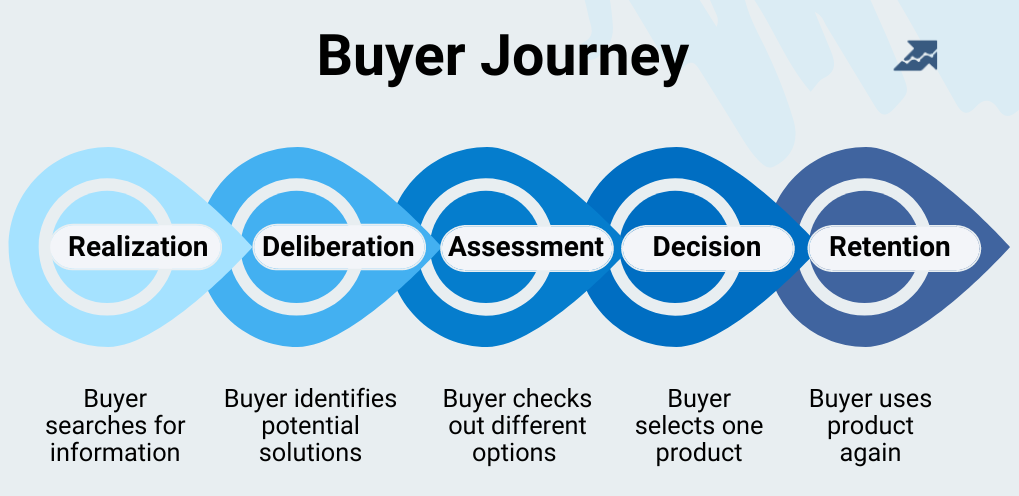
That's where building a defined customer journey map for your brand comes in. There are different stages in this journey. Therefore, your marketing strategy must be customer-centric and designed to meet leads at every touchpoint and guide them to the next stage until they become loyal customers.
- The Realization Stage: also known as the awareness stage, is when a potential customer recognizes the need to solve a particular problem. This is where you make the lead see that you understand their problem and can solve it.
- The Deliberation Stage: also known as the consideration stage, is where the lead starts identifying options. You can convince them that your product is the right solution during this stage. You can use different types of content optimized toward this goal.
- The Assessment Stage: also called the evaluation or nurture stage, is where potential customers start weighing different solutions to their problems. They're almost over the line and just need to be convinced about where to buy.
- The Decision Stage: this is where they choose which product to use.
- The Retention Stage: at this point, customers become repeat buyers.
6. Use SEO to Drive Organic Web Traffic
Consider that search engines, especially Google, start 68% of online experiences, according to a Brightedge report, and search engine users have more precise intentions. According to the same report, organic search tops the chart for trackable web traffic and remains the most prominent digital channel for lead generation.
When you attract people to your website through search engines, you get leads that search for solutions you're already offering. That means they're already halfway to becoming customers.
The trick with SEO is having a sound strategy and building your website to rank higher on search results. Ranking higher is essential because, according to Moz, searchers spend less than one minute entering a search and deciding which result to open. So, the higher your website is on the result page, the higher your chances of attracting leads.
That said, you need to focus on several key areas and models to get actual results. Your in-house team or outsourced SEO agency can handle these SEO aspects.
Run an SEO Audit
You can use your Google Search Console account to conduct a quick SEO audit. Go to the Coverage report section once you log into the account to see your indexed pages in Google. You can then use the details section to find errors that Google may be experiencing with your page.
You can also use tools like Serpstat's Site Audit feature to check other SEO-related issues and get an audit summary.
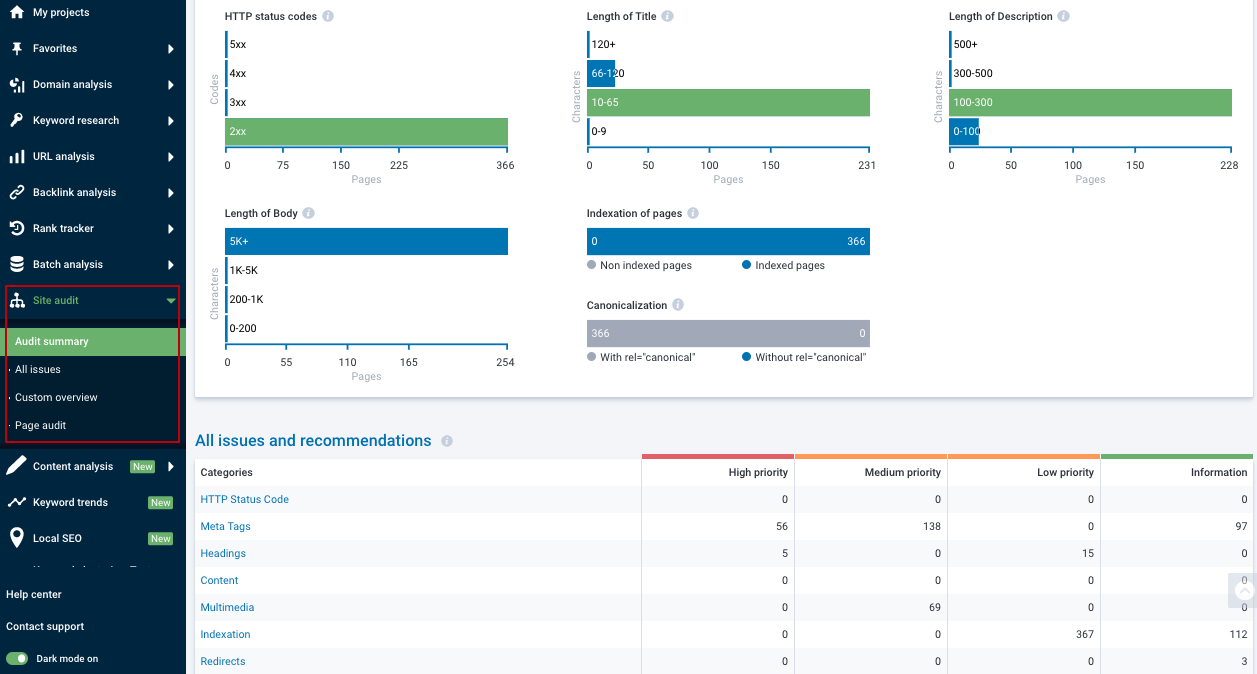
- Scan any separate page to check for technical issues.
- Sort out technical issues on your site by their priority, and fix issues that have an impact on your rankings.
- Track the growth dynamics of the site optimization level.
- Schedule automatic checks, and monitor if the number of issues found is decreasing.
Want to test a comprehensive Site Audit tool?
Click the button below and sign up for a free 7-day trial!
Carry Out Keyword Research
When working on your SEO content and efforts, you'll be targeting the wrong audience by using the wrong keywords, or not using keywords.
The right keywords, on the other hand, serve as your SEO compass and provide a basis for your strategies. They help you understand your target audiences, how they respond to messages, and where to find them.
You can then use all that data to create the right content to attract and convert them.
- How do you go about Keyword Research?
- How to come up with Seed Keywords?
The seed keywords come from your business niche and product offering. They're generic words and phrases that embody your product offering. Building a list of these keywords is easy since you already have a business.
For example, if your company produces software to track menstrual cycles, your keywords seeds should look like this:
- menstruation;
- menstrual cycle;
- ovulation;
- pregnancy;
- cramps.
While these keywords aren't valuable to target, they'll help the tool generate lists of keywords your likely buyers are searching for.
- Use a Keyword Research tool
With Serpstat's Keyword SEO research feature, you can find the right keywords for different pages on your website. You can learn about your competitors, find out your potential buyer's questions, and peruse in-depth SERP analysis.
You should forget about the competition tab in the tool, as it's only relevant to advertisers. It merely shows how much advertisers are willing to fight for a particular keyword.
Other excellent free tools can help you with your keyword research. They include Google Search Console, Google Trends, and Google Analytics. While these free tools will help with basic keyword research, you'll have to hop on the paid plans for most to get more valuable data. They're SaaS companies, after all.
- Analyze Keywords
The good thing is that there are different metrics and factors that help you identify those ideal words and phrases.
For example, the Serpstat Keyword Research tool fetches all search terms containing your set keywords. The software compiles all the results and includes critical data, such as:
- search volume, which is the number of times a phrase is searched for within a given period;
- cost per click, which is the cost of using the Pay-Per-Click model to advertise in the SERPs of that specific query;
- return rate, which is the average number of times a user searches for the same term again within 30 days, and many more.
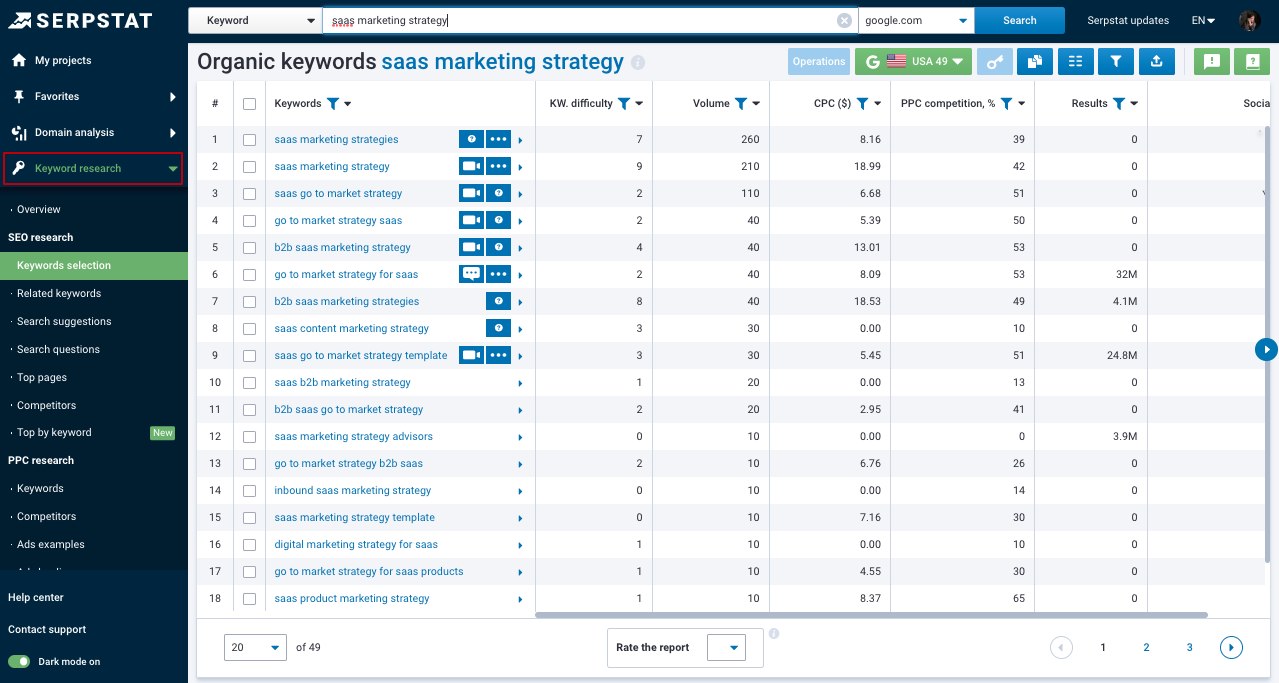
- Discover the Right Keywords to target
You should also consider going for less competitive keywords if you're a startup without the funds to fight for highly competitive keywords.
Competitive keywords are those with high search volumes, clicks, and traffic potential. They'll also be categorized as difficult keywords in your keyword research tool.
After knowing the right keywords to target, you can prioritize them and choose how to develop your content. And that brings us to Content Marketing for SaaS.
7. Content Marketing Strategies for SaaS
CoBloom conducted an analysis of 250 top SaaS companies in the world. It found the following:
- 36% of the leading SaaS organizations run an educational blog.
- Educational blogs drive 14% more organic traffic than news-focused and PR blogs.
- Top-performing blog posts receive 246 more shares on social media platforms.
- The top 10% of blog posts attracted 2,514 monthly organic search visitors.
These numbers show how content marketing is at the core of your entire marketing strategy. It pulls leads from different areas and guides them through the customer journey.
If you're going to pull traffic and build a healthy consumer relationship through content, you must use unique content marketing strategies, not some remix of what your competitors are doing.
But you still must check out your competitors to see how their content performs across different platforms to streamline your approach.
Best Strategies for SaaS SEO Content Marketing
You'll have to create blog posts and other content types, but how you approach them matters. Let's show you what works.
- Use topic clusters
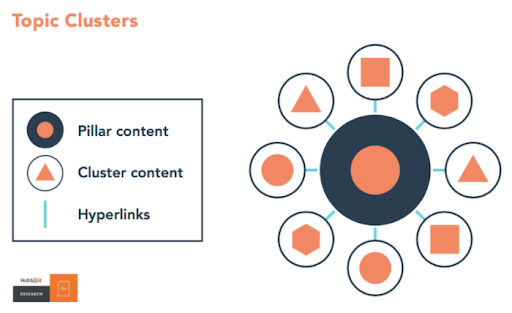
Using topic clusters is a way to show Google and other search engines that you're an authority on a subject. Let's go through an example.
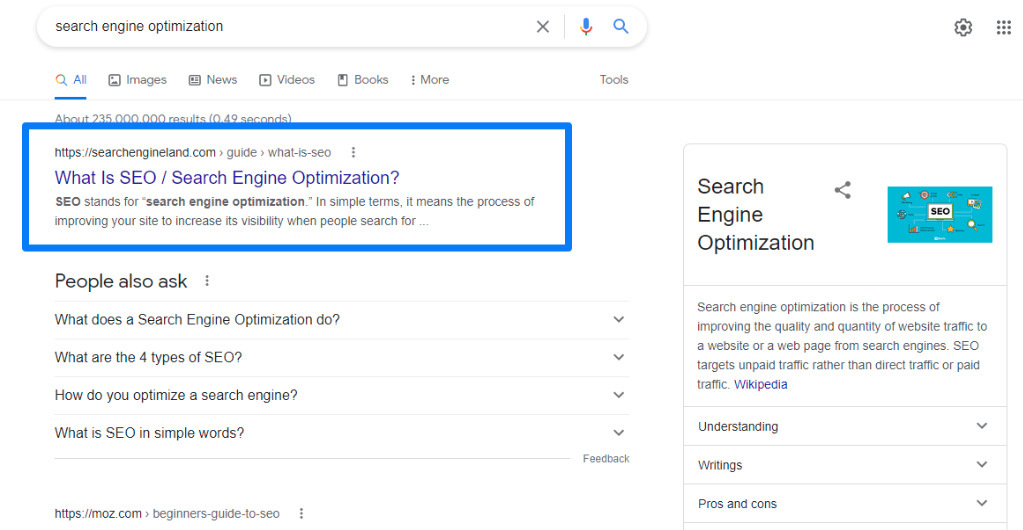
When you open the article, you'll find links to pages that will guide you through the SEO learning journey. This page is known as a pillar cluster page.
- Build topic clusters
After that, brainstorm sub-topics that expand your customers' knowledge about the subject. Remember to do keyword research for each subtopic and infuse your buyer personas into the process. You can now create your content.
Ensure you link them all together, track each page's performance, and improve your overall topic cluster strategy as you go.
- Use storytelling
You can use accounts from existing customers to explain a product's effectiveness instead of outlining the product's benefits.
- Run a Search Engine Optimized SaaS Blog
While your posts are optimized for SERPs, the reader must be your primary focus. That's because they'll leave your site as fast as they found it if you don't provide valuable information.
- Include thoroughly researched information.
- Use storytelling.
- Create short paragraphs.
- Get rid of unnecessary jargon and use simple words.
- Link to other posts that provide more information about a topic.
- Use long-form, scannable content of 2,000 words and more.
- Use a well-defined headings structure of H1, H2, and H3 tags.
- Add high-intent keywords to your headers and sub-headers.
- Use featured snippets to answer questions directly.
- Add keywords to your meta descriptions.
- Add keywords naturally, don't just stuff them in.
- Add links to high-authority websites.
- Link to other helpful articles on your blog.
- Reduce image size to boost site speed.
- Allow guest posts on your blog
Guest posts can make you an authority within your industry. They also help you foster great relationships with other thought leaders and build credibility around your brand and services. While guest posts are essential and beneficial, they should be monitored and validated at all times.
You must ensure the guest author writes educational and high-quality content relevant to your service offerings. Avoid guest posts with low-quality content, and make sure they follow your SEO guidelines for blog posting.
Guest writers should not include spammy links to your site, as Google will likely penalize you.
Serpstat team is always ready to cooperate with genuine experts in SEO/PPC and Digital Marketing spheres.
If you want to contribute and write the guest post — feel free to read the guidelines.
8. Design an Effective Link-Building Strategy
Backlinks remain one of the top-three factors for Google's search rankings. Google sees links to different parts of your website as proof that you produce quality, helpful content. And when those links come from other authoritative sites, it'll recommend your posts to users by ranking them higher on its SERPs.
So how do you go about link-building?
Create High-Quality Linkable Content
If your website contains good enough resources, you'll receive numerous backlinks. That said, you have to produce the types of content that attract quality backlinks. For example, websites with long-form content enjoy 77.2% more backlinks than those with short content.
Content types that are great link magnets include:
- statistics;
- infographics;
- guides;
- long-form articles;
- pillar pages;
- glossary pages;
- customer testimonials and stories;
- product comparison pages;
- opinion posts by founders and influencers.
Write Guest Posts for High Authority Websites
You have to pitch article ideas and produce highly optimized content that will also help the blog's readers and their SEO efforts. While these websites have strict guest posting standards, you'll be rewarded with a link to your website for your efforts.
Note that you may have to pay for some guest posts, especially on popular blogs and publications.
Use Digital PR
Create relationships with niche bloggers and journalists to make it work. Then offer them newsworthy content that will benefit the publishers.
Exchange Product Offerings for Links
For example, if your product is a quick calculating tool, they could add the “Powered by” and add a link to your website.
Track Down Your Unlinked Resources
The same goes for images related to high-quality content like statistics, graphs, and infographics.
Rebuild Broken Links
You should update your website from time to time by removing and editing pages. Of course, this activity can cause a heavy mess, especially if the pages you moved or removed already had backlinks. But things can become less complicated if you use such a tool I've mentioned earlier.
Before updating any web page kink or removing it, reach out to publishers of its backlinks and get them to make the required changes.
Nevertheless, you can always check the Backlink Profile and Domain Rank score using the Backlink Analysis tool from Serpstat.
9. Video Marketing
Consider that YouTube is the second most visited website in the world after Google, and 78% of users get their content from the platform. It goes to show how many potential customers are waiting to be converted.
On top of that, Google now uses video content as part of its search ranking factors. So, including videos on your website will boost your traffic!
Creating educational and fun videos will guarantee your audience will spend more time browsing through the site, which can lead to more sales conversions.
→ Create a plan for your video with relevant stakeholders.
→ Set a Schedule and Budget for your video.
→ Choose the platform that works for your services.
→ Choose your message type.
There are many video streaming platforms that can be adopted for marketing your SaaS: Vimeo, Vidyard, Wevideo, Wistia, Powtoon, Filmora, Wave Video, etc. You can use educational videos, customer testimonials, product demo videos, and answer FAQs in videos.
10. Email Marketing
Although email marketing may have been around for a while, it is still very efficient for converting leads to sales. A 2015 DMA email marketing study showed a $38 return on investment (ROI) for every $1 spent on an email.
Develop Your Email List
Typically, you'll have to create a form to activate the download button for these resources. And the good thing is that those who fill out the forms are open to receiving promotional emails.
Use Email Service Providers for Marketing
They make sure your emails are properly delivered without being flagged as spam.
You can use ESPs such as MailChimp, Zoho, and ProtonMail. While Gmail and Yahoo offer free individual email clients, you can also use their paid business plans.
Consider Different Types of Email Marketing Campaigns
- Email NewsletterYou can use newsletters to send information about updates, tips, or newsworthy information to your email list.
To create the perfect newsletter, you must ensure that you have defined your goals and target audience. Use visually pleasing templates to create your newspaper, and endeavor to keep the content concise and specific. - Promotional EmailsPromotional emails attach incentives to the information being passed, thus prompting the reader to click on your promo offering and convincing them to make a purchase.
For example, if the prospects bounce off your page after seeing your pricing, you can send a promotional email, offering them a discount. - Acquisition EmailsThis involves using emails to acquire or grow your customer base. To achieve the objective of acquisition emails, you can run campaigns using sponsorship emails.
- Sponsorship EmailsSuch emails enable you to reach a different audience, not on your email list. It involves the use of paid ads. You could pay for a copy of your email to be included in other newsletters or email campaigns.
One benefit of sponsored emails is that you can be specific about the segment or audience you want to reach. - Retention or Re-engagement EmailsPart of tracking your email list is determining your user personas' active and inactive. Re-engagement emails can be sent out to inactive customers once discovered.
Information can be tailored to request customer feedback about your services. When you get a response from them, you can win them back by offering promos and other ways to improve your service to them.
11. Social Media Marketing
And as it turns out, almost all your potential buyers are on at least one social media channel.
Consider that:
- LinkedIn boasts 830 million active users in 200 countries.
- Twitter had 229 million active daily users in 2022's first quarter.
- Facebook's active daily user accounts in Q1 of 2022 reached 1.96 billion.
- 90% of Instagram users follow a business.
So how do you build a social media strategy?
Identify the Preferred Platforms of Your Ideal Targets
Once you discover where to focus your marketing efforts, ensure you use the platform effectively. For example, Social Sprout reports that the best time to post on Twitter is 9 am on Mondays, Tuesdays, Wednesdays, Fridays, and Saturdays.
Research Your Competitors
Of course, it's a bad idea to repeat whatever your competition is doing. Your targets will get bored with your brand and rate you low if they see copied content on your social media pages.
Checking out your competitor's social media marketing efforts means discovering things you can do better.
Use Paid Social Media Advertising
The great thing is that these platforms optimize their advertising to target the right audiences. It then falls on you to provide the right content for these ads.
Leverage Twitter Spaces
You can schedule space and set a reminder ahead of time for attendees. Your spaces image card will be visible to your followers, but you can further amplify its reach using a Promoted Tweet.
Twitter Spaces helps you spread awareness because followers of attendees will be notified about the event. You can share tweets with links during each Spaces event to attract new leads to your website.
12. Pay-Per-Click Advertising
Pay-per-click advertising comes in when you can't wait to build your web pages to rank number one, especially if you don't have the funding.
With a solid PPC campaign, you can get your products in front of your target audience faster and fill your sales funnel. That said, SaaS PPC is also a hotly contested space. That's because keywords can be expensive if many brands are competing for them.
So, you have to know the right keywords to target and use the best PPC policies.
Understand PPC Quality Score
If your grades are excellent, it keeps using your ads and continues to get more clicks (and make more money).
Here are quick tips to boost your quality scores with Google:
- Make sure the loading speed of your landing page is fast.
- Your URLs should contain your targeted keywords.
- Stick to advertising one offer per ad instead of multiple offers per ad.
- Use mobile-friendly ad extensions.
- Optimize your ad copy to entice users.
- Your landing page and ad headline should also contain targeted keywords.
Work On Improving Your Click-Through-Rate
So, you must make your ads catchy, address your target audience's pain points, effectively show your unique selling proposition, and include social proof.
13. Affiliate Marketing
Look at your budget for affiliate marketing and offer affiliate partners more than your competitors give them. You can target smaller community-based influencers if you can't go for big brand influencers.
Always collaborate with your affiliates to correctly state your brand's unique selling proposition.
Main Takeaway: Develop a Retargeting Strategy
Your SaaS brand can increase revenue by 25 to 95% if it can boost its customer retention rate by 5%. Also, retaining old customers is 6 to 7 times less expensive than acquiring new ones.
To retain customers, ensure you're doing the following:
- Providing top-notch post-purchase support.
- Including in-depth resources on how to use your products, from a user manual to FAQs and informational guides.
- Requesting feedback.
- Offering referral rewards and exclusive discounts.
Speed up your search marketing growth with Serpstat!
Keyword and backlink opportunities, competitors' online strategy, daily rankings and SEO-related issues.
A pack of tools for reducing your time on SEO tasks.
Discover More SEO Tools
Domain Analysis Tools
SEO Domain Analysis – gain insights into your website's strengths and weaknesses
URL Inspection Tool
Uncover hidden SEO opportunities with our powerful URL Inspection Tool
Keyword Rank Checker
Google Keyword Rankings Checker – gain valuable insights into your website's search engine rankings
Competitor Website Analytics
Complete analysis of competitors' websites for SEO and PPC
Recommended posts
Cases, life hacks, researches, and useful articles
Don’t you have time to follow the news? No worries! Our editor will choose articles that will definitely help you with your work. Join our cozy community :)
By clicking the button, you agree to our privacy policy.

